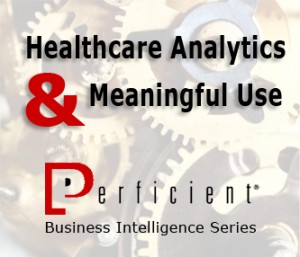 Perficient has created this series, “Healthcare Analytics and Meaningful Use” to drive discussions around unlocking the true potential of EHRs with analytics. Stay tuned for this four-part series to be published throughout October and November. We welcome your comments and questions below.
Perficient has created this series, “Healthcare Analytics and Meaningful Use” to drive discussions around unlocking the true potential of EHRs with analytics. Stay tuned for this four-part series to be published throughout October and November. We welcome your comments and questions below.
Healthcare leaders such as Kathleen Sebelius and David Blumenthal claim that the HITECH Act, which allots roughly $20 billion to encourage the use of electronic health records (EHRs) is a victory for “health policy leaders on both sides of the aisle [who] have urged adoption of electronic health records” because it will “improve quality of care and ultimately lower costs”. However, much of the population still questions how EHRs contribute to solving the healthcare conundrum.
According to David Blumenthal, the National Coordinator for Health Information Technology, EHRs act as “an electronic circulatory system for health information that nourishes the practice of medicine, research and public health, making healthcare professionals better at what they do and the American people healthier.” From the sounds of it, EHRs harness unbelievable power, but it is important to understand that the implementation of EHRs is simply a “first step” and that the true value of EHRs lies in their potential – not simply their implementation and existence.
Surveys have showed that up to 78% of patients believe EHRs boost care. I’m encouraged by these stats, but I always thinks, ‘Just wait until patients see what all of the technologies that EHRs enable can do.’ The value of EHRs comes from applying analytics to the data captured in EHRs. It is the analytics that allow organizations to achieve the Meaningful Use objectives defined within the HITECH Act of improving healthcare quality, engaging patients, improving the coordination of care, ensuring privacy and security as outlined in HIPAA, and improving population and public health.
Meaningful Use is divided into three stages. Stage 1 focuses on data capture and specifically targets 24 objectives for hospitals and 25 objectives for physicians. There are 15 quality measures for hospitals and 44 for physicians of which they must respond to 6 in Stage 1. Stage 2 includes adding clinical processes to the data set and Stage 3 targets performance and quality. The three step process to become 100% Meaningful Use compliant reaffirms that the value of EHRs comes from the analytic power applied to the data captured in EHRs.
Healthcare analytics allow organizations to capitalize on data. Today’s healthcare analytics provide accurate and timely information throughout an organization. They impact processes, initiatives and the overall performance of departments throughout an organization. Healthcare analytics have the power to change operations and clinical processes – and ultimately impact patient safety, quality of care and improve efficiencies.
However, to unlock the power of EHRs, analytics are necessary. In the next post, we will examine what healthcare analytics look like to users and how they impact organizations.
Want to learn more? Register for our upcoming analytics webinar and you will be entered to win one of two Perficient client badges to the February HIMSS Conference in Las Vegas!
